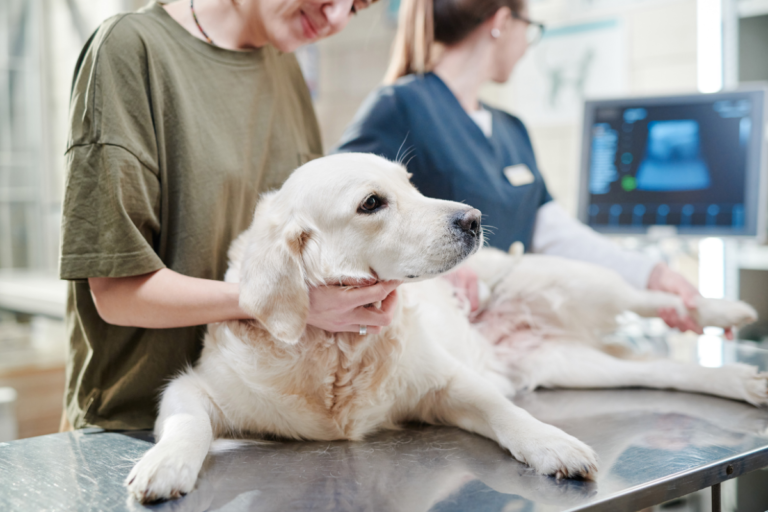Together for Wellness: Noticing Dog Diabetes Symptoms in Our Dogs
Understanding Dog Diabetes Symptoms
Dog diabetes is a big deal and needs quick action. Spotting the early signs and knowing what causes this illness can really help us care for our pups better.
Signs of Diabetes in Dogs
At first, dog diabetes might be sneaky, but it gets clear as time goes by. Keep an eye out for these signs:
- Extra Thirst: One of the first clues. Dogs might start gulping water like they’re in the desert (AVMA).
- Extra Bathroom Trips: Since they’re drinking more, they’ll need more potty breaks (PetMD).
- Hungry Hungry Doggo: Even with a bigger appetite, they might drop pounds.
- Weight Drop: They slim down even if they’re eating more (PetMD).
- Lazy Bones: You might notice they’re moving less and napping more.
- Vision Woes: Something like cataracts can cause cloudy peepers and sight issues.
- Frequent Ailments: Urinary infections might become regular.
- Parched Pup: Too much peeing might leave them dehydrated.
- Sweet Peet: Urine might smell sugary, feel sticky, and even shine like a syrup a bit.
| Symptom | Description |
|---|---|
| Extra Thirst | Drinking way more water |
| Extra Bathroom Trips | Frequent peeing |
| Hungry Hungry Doggo | Eating tons |
| Weight Drop | Losing pounds |
| Lazy Bones | Less playful |
| Vision Woes | Cloudy eyes or sight loss |
| Frequent Ailments | Lots of urinary infections |
| Parched Pup | Not enough fluids |
| Sweet Peet | Sugary, sticky pee |
Wanna know more about dog illnesses? Check out our dog diseases and symptoms guide.
Age and Gender Factors
Some dogs are more likely to get diabetes based on how old they are and whether they’re boys or girls. Middle-aged and senior pups are generally more at risk.
| Factor | Details |
|---|---|
| Age | Mid to older pups in the danger zone |
| Gender | Lady dogs are more vulnerable |
Keeping tabs on these factors helps us spot dog diabetes symptoms early. A regular vet visit and a good knowledge of these signs mean we can catch diabetes early and deal with it better. For insights into specific breed health, see our articles on beagle health problems, shih tzu health problems, and rottweiler health problems.
Diagnosing Dog Diabetes
Alright, folks, we’re here to make sure our canine pals stay as healthy as possible, and that means being on the lookout for symptoms of diabetes. Our waggy-tailed friends rely on us to spot these signs, so understanding the condition and nailing the diagnosis is super important.
Testing and Analysis
Getting to the bottom of diabetes in dogs mainly involves some straightforward tests. Vets look at both blood and urine samples to figure out what’s going on. Spotting high sugar levels in these tests is a pretty big hint the pup might have diabetes. Here’s the lowdown on what these tests involve:
- Blood Sugar Check: This is all about seeing how much sugar is hanging out in your dog’s blood. Usually, it’s between 70 mg/dL and 140 mg/dL when things are fine and dandy.
- Pee Check: Finding sugar in urine? That’s not normal and points toward diabetes.
- Fructosamine: This one gives the skinny on blood sugar averages over the last few weeks.
- Infection Screening: Diabetes can be a buddy to urinary tract infections, so testing for these is a common extra step.
| Test Type | Normal Numbers | Diabetes Alert |
|---|---|---|
| Blood Sugar | 70 – 140 mg/dL | Over 200 mg/dL |
| Urine Sugar | None | Found |
| Fructosamine | Under 400 µmol/L | Above 400 µmol/L |
Sometimes the doc might toss in a couple more tests just to cover all bases, especially with those sneaky infections that like to tag along with diabetes.
Risk of Diabetic Ketoacidosis
Watch out for this one – Diabetic Ketoacidosis (DKA). It’s a serious deal that happens when the body breaks fat apart at lightning speed due to not having enough insulin, bringing those nasty ketones into play. These little guys turn your dog’s blood all acidic, which is a no-go.
Look out for:
- Massive fatigue
- Puking
- Raspy, fast breathing
- Weak muscles
- Breath that smells like nail polish remover
If any of this pops up, don’t waste a second getting your vet involved. They’ll likely run some checks on blood ketones and the acid levels to make a call on DKA.
Conclusion
So, caring for a diabetic dog means being a bit of a detective. You gotta pick up on clues like them hitting the water bowl too often or leaving puddles more than usual. Team up with your vet to get the right diagnosis via those trusty blood and urine tests. Keeping a sleek eye on your dog’s overall health while sticking close to your vet is vital. We’ve got loads more info if you’re interested in learning about stuff like bloat or heart problems in dogs. Bottom line: with quick diagnosis and care, our four-legged buddies can keep living their best lives. For more nifty tips on handling diabetic dogs, head over to healthy hounds.
Managing Diabetes in Dogs
Living with a diabetic dog is like having a furry nurse on constant alert. We gotta stay sharp with their treatment plans and understand the dollars and cents that come with it all.
Treatment Approaches
Dealing with diabetes in dogs is mostly about two things: sticking needles in insulin and making sure chow time fits the healthy bill. These are the bread and butter for keeping sugar levels in check and letting our pups enjoy life.
-
Insulin Therapy: Our diabetic dogs usually need a couple of shots of insulin every day. The amount of insulin is like a custom suit, fitting each dog just right, and it’s our job to do regular check-ups to tweak it as we go along. It’s part of our daily grind, like morning coffee or that unending pile of laundry.
-
Diet Changes: Diet is a big deal. Going for high-fiber, low-fat munchies helps keep the sugar waves at bay. We gotta be meal-time ninjas, keeping feed times in sync with those insulin jabs (Kennel Club Health Checker).
-
Regular Veterinary Visits: We gotta be on our toes with frequent trips to the vet to see how our dog’s holding up and tweak the game plan if necessary. If they suddenly eat like a horse, drink like a camel, or pee like a fountain, it’s time to give the vet a ring (Healthy Hounds).
Cost of Diabetes Care
The wallet takes a bit of a beating with diabetes care, but it’s part of signing up for the long haul. Here’s a rough idea of what we’re looking at:
| Expense Type | Estimated Cost |
|---|---|
| Insulin | $40 – $150 a month |
| Special Diet | $30 – $60 a month |
| Blood Work | $100 – $200 a pop |
| Check-ups and Misc. | $100 – $300 a year |
| Annual Total | Around $2,500 every year |
Numbers can shift a bit depending on how tricky the diabetes is and where exactly we’re hanging our hats. But putting the bucks into keeping our fur buddy healthy means better days ahead and maybe some extra time together (Care Costs).
Being aware of what we’re diving into helps us make smart choices and set the right expectations. If you’re curious about other doggie dilemmas like dog heart disease or kidney trouble in canines, our little corner of the web is packed with useful tidbits.
Through it all, staying buddy-buddy with our vet and being on top of our dog’s needs is the name of the game. Managing diabetes is part of our everyday hustle, and it’s all about giving our pups the best shot at living their best, wagging life.
Monitoring and Care for Diabetic Dogs
Taking care of our diabetic dogs is all about keeping an eye on things. We need to be on the lookout for changes and deal with problems as they pop up. Here’s how we make sure our pups stay happy and healthy.
Regular Monitoring
Keeping tabs on our dogs is super important. Checking in regularly helps us spot any changes early so we can tweak how we care for them. Vets of the Rockies suggest that watching out for changes in potty habits and keeping an eye on urinary tract infections helps avoid bigger problems later.
Here’s what we should focus on:
- Insulin Administration: Giving insulin on the daily is a must. We need to tweak the dose here and there based on how our dog’s doing to keep their blood sugar just right.
- Blood and Urine Tests: A blood and pee check-up every month or so is a pretty good idea once things are stable (VCA Hospitals).
- Glucose Monitoring: More folks are doing glucose checks at home now. Gadgets like AlphaTRAK®2 and FreeStyle Libre® help us chart out the glucose levels and figure out the best insulin amounts.
| Monitoring Aspect | Frequency | Tools/Methods |
|---|---|---|
| Insulin Administration | Daily | Vet’s directions |
| Blood Tests | Every 1-3 months | Vets, Home Glucose Gadgets |
| Urine Tests | Every 1-3 months | Vets |
| Glucose Curves | Regularly (as in vet’s advice) | Home Glucose Gadgets |
Got more questions about dog health? Head over to our page on dog diseases.
Potential Complications and Response
Knowing what could go wrong and how to react can really change things for our diabetic dogs.
-
Diabetic Ketoacidosis (DKA): This is when too little insulin causes high sugar and ketone levels. Look out for tiredness, throwing up, and fast breathing. It’s a get-to-the-vet-now situation (Vets of the Rockies).
-
Hypoglycemia (Low Blood Sugar): If you notice weakness, shaking, or worse—seizures, it could be low sugar. Keep honey or corn syrup handy to fend off the bad stuff.
More on handling these symptoms found in our guide on seizures in dogs symptoms.
-
Urinary Tract Infections (UTIs): Diabetic dogs might get UTIs more often, making things worse. Routine pee checks and vet visits help keep these in check.
-
Cataracts and Blindness: Diabetes could cloud their eyes. Regular eye check-ups help catch this in time (VCA Hospitals).
Picking up on issues early makes a world of difference. Keeping up with vet visits and home checks ensures our dogs enjoy a fulfilling life.
Want to learn more? Take a look at our articles on female dog bladder infection symptoms and dog gum disease.






